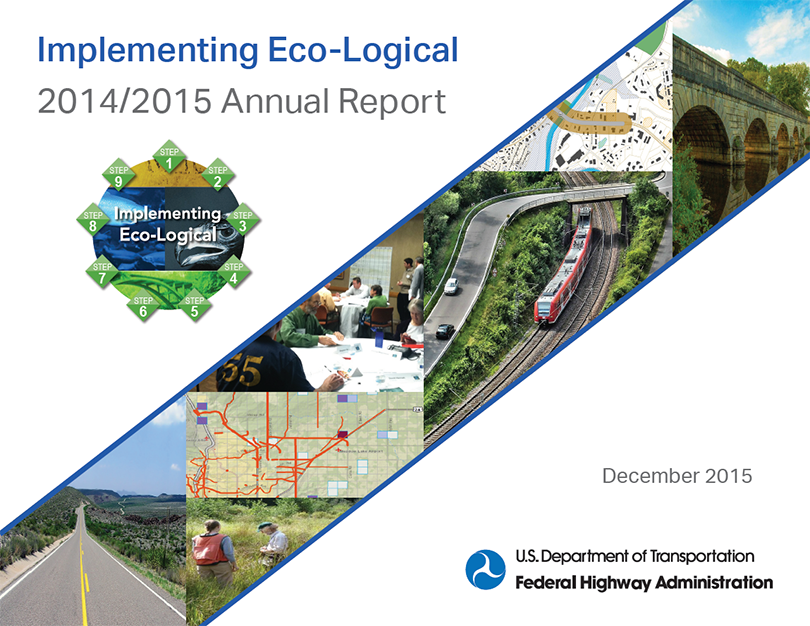
Cover art sources: Landscape images courtesy of Creative Commons (Public Domain), from top:
Bridge image: “Creative Commons Five Arch Bridge-Virginia-Water” by diego_torres used under CC BY.
Train/overpass: “Creative Commons Train-Railway-Vineyard” by heitu used under CC BY.
Highway: “Creative Commons Big Bend-Texas-Landscape-Scenic” by tpsdave used under CC BY.
Map (top right) and stakeholder meeting image courtesy of the Charlottesville-Albemarle Metropolitan Planning Organization, map (bottom left) courtesy of the Pikes Peak Area Council of Governments, and field collection image courtesy of the New Hampshire Department of Transportation.
Printer-friendly PDF of this report (23.6 MB)
Notice
This document is distributed by the U.S. Department of Transportation, in the interest of information exchange. The United States Government assumes no liability for its contents or use thereof. If trademarks or manufacturers’ names or products are mentioned, it is because they are considered essential to the objective of the publication and should not be considered as an endorsement. The United States Government does not endorse products or manufacturers.
Quality Assurance Statement
The Federal Highway Administration (FHWA) provides high-quality information to serve Government, industry, and the public in a manner that promotes public understanding. Standards and policies are used to ensure and maximize the quality, objectivity, utility, and integrity of its information. FHWA periodically reviews quality issues and adjusts its programs and processes to ensure continuous quality improvement.
Acronyms and Abbreviations
| AASHTO |
American Association of State Highway and Transportation Officials |
| BLM |
Bureau of Land Management |
| DOT |
Department of Transportation |
| EPA |
U.S. Environmental Protection Agency |
| ESA |
Endangered Species Act |
| FHWA |
Federal Highway Administration |
| GIS |
Geographic Information Systems |
| IAP |
Implementation Assistance Program |
| IEF |
Integrated Ecological Framework |
| LRTP |
Long-Range Transportation Plan |
| MOA |
Memorandum of Agreement |
| MOU |
Memorandum of Understanding |
| MPO |
Metropolitan Planning Organization |
| NEPA |
National Environmental Policy Act |
| NGO |
Non-Governmental Organization |
| NOAA |
National Oceanic and Atmospheric Administration |
| NPS |
National Park Service |
| REF |
Regional Ecosystem Framework |
| RTP |
Regional Transportation Plan |
| SHRP2 |
Second Strategic Highway Research Program |
| SVM |
Shared Value Mitigation |
| TRB |
Transportation Research Board |
| USACE |
U.S. Army Corps of Engineers |
| USFS |
U.S. Forest Service |
| USFWS |
U.S. Fish and Wildlife Service |
| REPORT DOCUMENTATION PAGE |
Form Approved
OMB No. 0704-0188 |
| Public reporting burden for this collection of information is estimated to average 1 hour per response, including the time for reviewing instructions, searching existing data sources, gathering and maintaining the data needed, and completing and reviewing the collection of information. Send comments regarding this burden estimate or any other aspect of this collection of information, including suggestions for reducing this burden, to Washington Headquarters Services, Directorate for Information Operations and Reports, 1215 Jefferson Davis Highway, Suite 1204, Arlington, VA 22202-4302, and to the Office of Management and Budget, Paperwork Reduction Project (0704-0188), Washington, DC 20503. |
| 1. AGENCY USE ONLY (Leave blank) |
2. REPORT DATE
December 2015 |
3. REPORT TYPE AND DATES COVERED
Final Report (June 2014 - July 2015) |
4. TITLE AND SUBTITLE
Federal Highway Administration 2014/2015 Implementing Eco-Logical Program Annual Report |
5. FUNDING NUMBERS
|
6. AUTHOR(S)
Rachel Strauss, Kate Macfarlane, Anjuliee Mittelman, Haley Peckett, Jordan Wainer, Logan Nash, Julianne Schwarzer |
7. PERFORMING ORGANIZATION NAME(S) AND ADDRESS(ES)
John A. Volpe National Transportation Systems Center
U.S. Department of Transportation
55 Broadway
Cambridge, MA 02142 |
8. PERFORMING ORGANIZATION REPORT NUMBER
|
9. SPONSORING/MONITORING AGENCY NAME(S) AND ADDRESS(ES)
Federal Highway Administration
U.S. Department of Transportation
1200 New Jersey Avenue, SE
Washington, DC 20590 |
10. SPONSORING/MONITORING
AGENCY REPORT NUMBER
|
| 11. SUPPLEMENTARY NOTES |
12a. DISTRIBUTION/AVAILABILITY STATEMENT
This document is available to the public on the FHWA website at:
http://www.environment.fhwa.dot.gov/env_initiatives/eco-logical/grant_program.aspx. |
12b. DISTRIBUTION CODE |
| 13. ABSTRACT (Maximum 200 words): The Eco-Logical approach offers an ecosystem-based framework for integrated infrastructure and natural resource planning, project development, and delivery. The 2014/2015 Implementing Eco-Logical Program Annual Report provides updates on the Federal Highway Administration’s (FHWA) Eco-Logical Program, in particular the Implementing Eco-Logical initiative funded through the Second Strategic Highway Research Program (SHRP2) in coordination with the American Association of State Highway and Transportation Officials (AASHTO) and the Transportation Research Board (TRB). The report discusses program accomplishments of Implementing Eco-Logical as well as from Implementing Eco-Logical Implementation Assistance Program recipients. The report provides findings and updates on recipients’ projects and shares recommendations for next steps for the FHWA Eco-Logical Program. |
14. SUBJECT TERMS
Eco-Logical; Implementing Eco-Logical; Second Strategic Highway Research Program; Regional Ecosystem Framework; Integrated Ecological Framework; environment; transportation; ecosystems; ecosystem-based approach |
15. NUMBER OF PAGES
78 |
| 16. PRICE CODE |
17. SECURITY CLASSIFICATION OF REPORT
Unclassified |
18. SECURITY CLASSIFICATION OF THIS PAGE
Unclassified |
19. SECURITY CLASSIFICATION OF ABSTRACT
Unclassified |
20. LIMITATION OF ABSTRACT
Unlimited |
Table of Contents
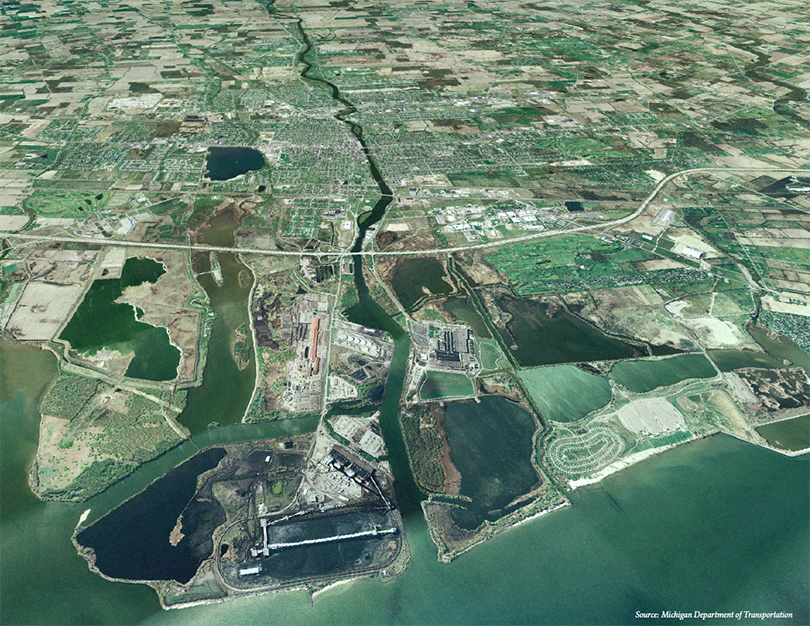
Source: Michigan Department of Transportation
To our Eco-Logical Practitioners, Readers, and Friends:
In April 2006, eight Federal agencies signed Eco-Logical: An Ecosystem Approach to Developing Infrastructure Projects, affirming their commitment to transportation planning at the ecosystem level. Today, this commitment continues through Implementing Eco-Logical, one of the many solutions under the Second Strategic Highway Research Program (SHRP2) led by the Federal Highway Administration (FHWA), American Association of State Highway and Transportation Officials (AASHTO), and the Transportation Research Board. As partners, FHWA and AASHTO manage Implementing Eco-Logical, a set of tools, steps, and activities that bring the Eco-Logical approach into practice.
In designing the 2014/2015 program activities (for the period June 2014 through July 2015), we wanted to focus on education, assistance, and tools, and I am immensely proud to say that we have made great strides in all of these areas. We kicked off our technical assistance activities by holding several workshops and peer exchanges, launching the On-Call Technical Assistance team, and convening a group of subject-matter experts known as our Eco-Logical Champions. We debuted a variety of resources to help explain and promote Eco-Logical—from our Eco-Logical Starter Kit website, to a Practitioner’s Handbook currently in development, to case studies featuring examples of the nine steps of the Eco-Logical approach in action.
Leaders in the field are also making great progress in applying Eco-Logical to transportation projects and plans. Several State departments of transportation and metropolitan planning organizations participating in our Implementing Eco-Logical Implementation Assistance Program have completed their projects, while others are scheduled to finish them by December 2015 and through early 2016.
Over the coming year, we will continue to educate agencies about Eco-Logical and provide assistance and tools to support implementation. New peer exchanges, workshops, and resources for the Starter Kit—including building a business case for Eco-Logical—are on the horizon. Through these activities, we aim to build a community of practice for implementing Eco-Logical. We hope that you will join us.
Sincerely,
David T. Williams
Environmental Protection Specialist
FHWA Office of Project Development & Environmental Review
December 2015
Executive Summary
Implementing Eco-Logical Implementation Plan Strategies
 |
Educate agency leadership. |
 |
Develop incentives or support for State and regional transportation agencies. |
 |
Provide technical assistance. |
 |
Develop a business case. |
 |
Develop new tools and technologies. |
 |
Develop communications and outreach materials. |
This 2014/2015 Implementing Eco-Logical Program Annual Report reviews the recent activities and successes of the Implementing Eco-Logical Program, led by the Federal Highway Administration (FHWA) and the American Association of State Highway and Transportation Officials (AASHTO), for the period of June 2014 through July 2015, as well as examples of Eco-Logical in use across the country.
Implementing Eco-Logical (C06) is one of many solutions under the Second Strategic Highway Research Program (SHRP2), a multi-agency partnership among FHWA, AASHTO, and the Transportation Research Board (TRB). Implementing Eco-Logical also complements FHWA’s existing Eco-Logical Program.
Both programs encourage the Eco-Logical approach, a process designed to help agencies engage in early collaboration to establish joint environmental priorities and identify critical resources when planning and developing infrastructure projects.
In 2012, FHWA, AASHTO, and TRB convened a group of Eco-Logical stakeholders to discuss strategies for advancing Eco-Logical. The resulting strategies formed the basis of an Implementation Plan, which guides FHWA and AASHTO’s activities for Implementing Eco-Logical (see right).
Program Accomplishments
FHWA and AASHTO are actively developing and delivering activities identified in the Implementation Plan strategies. Recent accomplishments in the past year include:
- Launched the Starter Kit website and online technical assistance request tool
- Engaged a team of Eco-Logical “Champions”
- Held three peer exchanges and one workshop
- Began development of two Eco-Logical case studies and the Practitioner’s Handbook
- Managed the Implementing Eco-Logical Implementation Assistance Program (IAP)
Findings and Recommendations
Upcoming Activities and Next Steps
FHWA and AASHTO continue to identify technical assistance needs and opportunities for the Implementing Eco-Logical Program. Upcoming activities include:
- Continuing organization of peer exchanges, workshops, and other technical assistance requests.
- Continuing coordination with IAP recipients.
- Fostering a community of practice among Eco-Logical practitioners and interested stakeholders.
- Continuing integration of Implementing Eco-Logical activities with other elements of the FHWA Eco-Logical Program.
Through input from the IAP recipients and the field, FHWA and AASHTO track opportunities and challenges often encountered when applying the Eco-Logical approach. These findings help shape recommendations for FHWA and AASHTO to consider when developing future Implementing Eco-Logical program activities. In addition, the findings demonstrate helpful ways that practitioners might explore applying Eco-Logical in their own agencies.
| Category |
Findings |
- Building and Sustaining Partnerships
|
1.1 |
Agencies implementing Eco-Logical recruit partners early in the process. |
| 1.2 |
IAP recipients use a variety of methods to promote consistent stakeholder engagement while respecting partners’ time constraints. |
| 1.3 |
Successful relationships established through IAP projects carry over into other projects, lay the groundwork for future collaboration, and result in new opportunities for streamlining. |
- Institutionalizing Eco-Logical into Agency Practices
|
2.1 |
In many cases, IAP project leads serve as “champions” for promoting Eco-Logical within their agency and building institutional knowledge. |
| 2.2 |
Formal agreements, such as memoranda of agreement or memoranda of understanding, can help promote long-term implementation of Eco-Logical by formalizing commitments and providing an institutional framework that is more resilient to shifting priorities and staffing changes. |
| 2.3 |
One way for agencies to support the long-term use of the Eco-Logical approach is to build connections with related initiatives within the agency. |
| 2.4 |
Support for Eco-Logical at the leadership level makes it much easier to institutionalize Eco-Logical into agency practices and ensure long-term implementation. |
- Quantifying and Communicating Results
|
3.1 |
Quantifying the benefits of applying the Eco-Logical approach—based on cost, time, or other savings—continues to be a challenge for agencies implementing Eco-Logical. |
- Developing Data, Tools, and Strategies
|
4.1 |
Eco-Logical data and tools are most effective when tailored to the region’s goals, priorities, and constraints. |
| 4.2 |
Some technical aspects of Eco-Logical, such as creating an REF or setting up a mitigation crediting program, require a level of specialized expertise that may present a barrier to entry for some agencies. |
NOTE: For the full list of recommendations, please click here.
Introduction
This 2014/2015 Implementing Eco-Logical Program Annual Report provides information on recent activities and successes of the FHWA-AASHTO Implementing Eco-Logical Program for the period June 2014 through July 2015.
Implementing Eco-Logical (C06), one of the many solutions under the SHRP2 Program led by FHWA, AASHTO, and TRB, advances Eco-Logical, an approach designed to help transportation, resource, and regulatory agencies integrate their infrastructure development and conservation planning processes and arrive at a joint set of environmental priorities.
As Implementing Eco-Logical complements FHWA’s existing Eco-Logical Program, this report also shares updates on these related program activities.
Return to Table of Contents ↑
Return to Top ↑
- PART ONE
- PART TWO
- PART THREE
Part 1: Program Overview and Activities
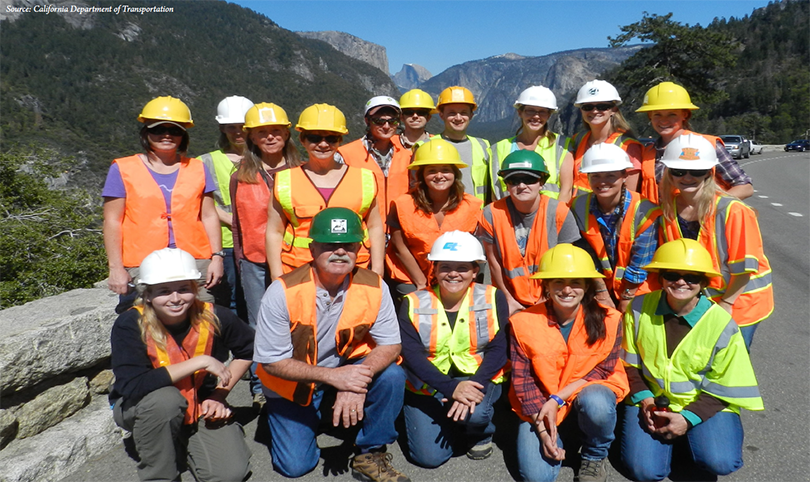
Source: California Department of Transportation
The Eco-Logical Approach
What is Eco-Logical?
Eco-Logical is a process designed to help agencies engage in early collaboration to establish joint environmental priorities and identify critical resources when planning and developing infrastructure projects.
- Eco-Logical uses a nine-step framework to guide agencies, known as the Integrated Ecological Framework (IEF) (see diagram at right). Agencies may complete the steps in order or non-sequentially to fit their needs.
- Eco-Logical formally began at the Federal level in 2002, with the creation of an interagency steering team of eight Federal agencies (known as the “Signatory Agencies”) and four State agencies. In 2006, the team jointly published Eco-Logical: An Ecosystem Approach to Developing Infrastructure Projects, which serves as the foundation for FHWA’s Eco-Logical Program and for the FHWA-AASHTO Implementing Eco-Logical Program.
The Regional Ecosystem Framework
Step 3 in the nine-step IEF is the development of a regional ecosystem framework (REF), a key product in applying the Eco-Logical approach. The REF is the consolidation of the data collected in Step 2 with land use and long-range transportation plans into a geospatial database.
Who is Implementing Eco-Logical?
Is your agency engaged in Eco-Logical but not listed
on the map?
Let us know.
There are more than 35 transportation agencies in the United States using the Eco-Logical approach today, including:
- 13 State departments of transportation (State DOTs) and metropolitan planning organizations (MPOs) funded through the SHRP2 Implementing Eco-Logical IAP; and
- 22 other transportation agencies that are using Eco-Logical to guide transportation plans or projects.
SHRP2 Implementing Eco-Logical
Select Milestones in the History of the SHRP2 Implementing Eco-Logical Program
FHWA’s Eco-Logical effort first began in 2002, when eight Federal agencies and four State DOTs convened to start developing what is now known as the FHWA Eco-Logical Program.
Today, FHWA and AASHTO continue to lead technical assistance and resource development efforts through the SHRP2 Implementing Eco-Logical initiative.
| 2002 |
National Eco-Logical Effort Begins
An interagency team of eight Federal agencies (known as the Eco-Logical “Signatory Agencies”) and four State DOTs convenes first meeting and starts development of the Eco-Logical Guide.
|
| 2006 |
Eco-Logical Guide Published
FHWA, with support from the Signatory Agencies and four State DOTs, publishes Eco-Logical: An Ecosystem Approach to Developing Infrastructure Projects.
FHWA Eco-Logical Program Established
|
| 2007 |
FHWA Launches Eco-Logical Grant Program
FHWA selects 15 projects across the country to receive funding to test an ecosystem-scale approach to infrastructure development.
|
| 2008 |
SHRP2 Research on Implementing Eco-Logical Begins
Implementing Eco-Logical is one of many solutions under SHRP2, a large-scale cooperative research program funded by Congress and administered by FHWA in coordination with AASHTO and TRB.
|
| 2010 |
FHWA Launches Eco-Logical Webinar Series
Signatory Agency Team Begins Bi-Annual Meetings |
| 2011 |
First SHRP2 Research Project on Implementing Eco-Logical Completed |
| 2012 |
SHRP2 Implementing Eco-Logical Implementation Plan Developed
The Implementation Plan identifies six strategies that guide FHWA and AASHTO’s implementation activities.
FHWA Holds Peer Exchange for Five Eco-Logical Grant Program Recipients
Continuation of webinar series and bi-annual signatory agency meetings
|
| 2013 |
Implementing Eco-Logical Implementation Assistance Program Launched
Continuation of webinar series and bi-annual signatory agency meetings
|
| 2014 |
Eco-Logical Self-Assessment Conducted
Eco-Logical Champions Identified
Continuation of webinar series and bi-annual signatory agency meetings
|
| 2015 |
Starter Kit Launched
On-Call Technical Assistance Team Established
One Workshops and Three Peer Exchanges Delivered
Continuation of webinar series and bi-annual signatory agency meetings
|
Implementation Strategies
Implementing Eco-Logical Program Strategies
In September 2012, a panel of experts representing FHWA, AASHTO, TRB, State DOTs, MPOs, and Federal resource and regulatory agencies developed an Implementation Plan for Implementing Eco-Logical.
The Implementation Plan identifies six strategies for engaging transportation agencies (see right).
These strategies guide FHWA and AASHTO’s implementation activities and complement or directly support the FHWA Eco-Logical Program.
 |
Educate agency leadership
- Identify and equip champions
- Offer executive training
- Develop Practitioner’s Handbook
- Conduct Eco-Logical self-assessment
|
 |
Develop a business case
- Make case studies widely available
- Conduct targeted outreach to stakeholders
|
 |
Develop incentives + support
- Provide incentive grants and assistance for implementation
- Offer awards and recognition
|
 |
Develop new tools + technologies
- Facilitate data management and access
- Develop an information clearinghouse
- Develop structures to foster collaboration1
|
 |
Provide technical assistance
- Develop technical assistance teams
- Sponsor peer exchanges and forums
- Develop a Starter Kit for Implementing Eco-Logical
|
 |
Develop communications + outreach materials
- Develop and implement a strategic marketing and communications plan
- Develop and distribute an informational video
|
1 This strategy relates to the development of new policies and PlanWorks, a web-based resource that highlights common decision points and opportunities for collaboration throughout transportation planning and environmental review processes. For more information, visit the PlanWorks website.
Icon Credits (all from the Noun Project; clockwise, from top left): Leadership: Samuel Q. Green; Business Case: N/A; Tools: Julie Reyes Villalta; Communications: romzicon; Technical Assistance: Gregory Radek; Incentives: Wilson Joseph
Tracking Performance of Implementing Eco-Logical Implementation Plan Activities
FHWA regularly monitors the status of activities relating to the six Implementing Eco-Logical strategies. As of July 2015, FHWA and AASHTO had made progress on or completed the following activities:
 |
Educate agency leadership |
30%
Identify and equip champions |
100%
Offer executive training
(completed 2014) |
65%
Develop Practitioner’s Handbook |
100%
Conduct Eco-Logical self-assessment
(completed 2014) |
 |
Develop incentives + support |
35%
Provide incentive grants and assistance for implementation |
In Progress
Offer awards and recognition |
|
|
 |
Provide technical assistance |
In Progress
Develop tech. assistance teams (complete 2014); continue technical assistance |
15%
Sponsor workshops
(one held; others to follow) |
20%
Sponsor peer exchanges
(three held; others to follow) |
95%
Develop a Starter Kit for Implementing Eco-Logical |
 |
Develop a business case |
35%
Make case studies widely available |
In Progress
Conduct targeted outreach to stakeholders |
|
|
 |
Develop new tools + technologies |
Some tools/technologies are being considered. It is important to note others are being developed and delivered by other SHRP2 solutions, including PlanWorks (C01). |
|
|
 |
Develop communication + outreach materials |
95%
Develop and implement a strategic marketing and communications plan |
0%
Develop and distribute an informational video |
|
|
Program Accomplishments
During the period June 2014 through July 2015, FHWA and AASHTO accomplished a variety of activities under the Implementing Eco-Logical Program, including:
Note:
This section uses the icons associated with the Implementing Eco-Logical Implementation Plan strategies to indicate the strategy that corresponds with the activity noted.
Activities not associated with an icon are those outside of the Implementing Eco-Logical Program (e.g., activities conducted solely by FHWA through its existing Eco-Logical Program.)
Icons not shown in this section did not have substantial program activity during the 2014/2015 report period.


Technical Assistance + Agency Engagement
FHWA and AASHTO’s technical assistance efforts and agency engagement activities focus on ways for transportation, resource, and regulatory agencies and their partners to apply, institutionalize, and learn about Eco-Logical. These efforts include on-call technical assistance, Eco-Logical Champions, and peer exchanges and workshops.
Eco-Logical Champions
by Agency Type
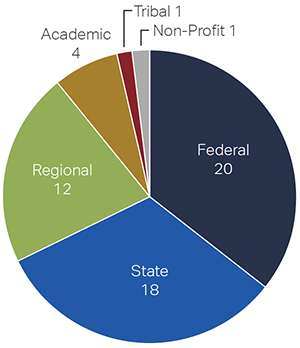
On-Call Technical Assistance Team
In January 2015, FHWA launched the On-Call Technical Assistance Team and created an online request form on the Eco-Logical website.
Since its inception, the Team has received requests from 9 MPOs, 10 State DOTs, 2 NGOs, and 1 individual. These requests have primarily been fulfilled through peer exchanges and workshops.
The Team provides responsive, individualized guidance and support to agencies as they implement the Eco-Logical approach. Team members assist with organizational, technological, regulatory, or scientific issues and questions.
Champions
Eco-Logical Champions are practitioners, partners, and researchers that are willing to “champion” the Eco-Logical approach within their own agencies and to partner with agencies and others in their professional networks.
Fifty-six individuals from Federal, State, Tribal, regional, academic, and non-profit agencies and organizations currently serve as Champions. They work to help increase understanding of Eco-Logical
among agencies and motivate greater participation in the Implementing Eco-Logical Program.
The Champions are also uniquely positioned to provide feedback from the field on the implementation of Eco-Logical. FHWA calls on the Champions to answer questions and provide insight to practitioners, present their expertise at webinars and conferences, and review drafts of products created by FHWA and AASHTO under the Implementing Eco-Logical Program.

Technical Assistance Peer Exchanges + Workshops
| State DOT Eco-Logical Programmatic Mitigation Peer Exchange March 2015 (2 days) |
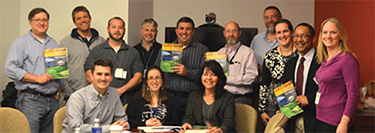 |
Purpose: State DOTs discussed their programmatic mitigation needs and made suggestions to each other to advance their individual programs. |
Product: Individual State DOT actions to address mitigation challenges in an Eco-Logical context.
Attendees: State DOTs from California, Colorado, Florida, and South Carolina; subject-matter experts included Lauren Diaz (USACE) and Deblyn Mead (USFWS).
|
| MaineDOT and Resource Partners Technical Assistance Workshop April 2015 (2 days) |
 |
Purpose: Participants focused on the development of a Programmatic Biological Assessment for Atlantic salmon and draft Mitigation Instrument related to the Maine DOT’s (MaineDOT) SHRP2 Implementing Eco-Logical IAP project. |
Product: An agreed-upon action plan and schedule.
Attendees: MaineDOT, USFWS, USACE, the National Marine Fisheries Service, and the Maine Department of Marine Resources. Facilitated by an organizational psychologist.
|
| MPO Eco-Logical Programmatic Mitigation Peer Exchange June 2015 (2 days) |
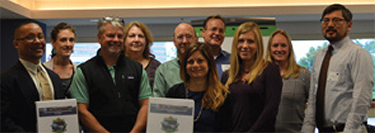 |
Purpose: MPOs discussed regional data-associated mapping tools and ways to share data to promote conservation objectives in their regions. |
Product: Individual MPO plans to enhance data sharing capabilities in their regions.
Attendees: MPOs in the St. Louis, San Francisco, San Diego and Dallas-Ft. Worth regions; Subject matter experts included Lauren Diaz (USACE) and Deblyn Mead (USFWS).
|
| Developing an REF: Eco-Logical at AASHTO SCOP/SCOE Conference July 2015 (1 day) |
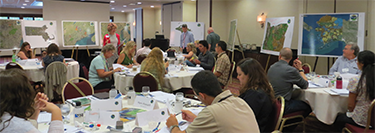 |
Purpose: Attendees learned the components of the REF and conducted mapping activities for their individual States during a day-long peer exchange held as part of the AASHTO Standing Committee on Planning (SCOP) and Standing Committee on Environment (SCOE) annual meeting. |
Product: Mapping exercises to test how an REF could benefit attendees’ programs.
Attendees: Environmental practitioners or transportation planners from 19 State DOTs. Moderated by practitioners from the Massachusetts DOT and Oregon DOT.
|
Images courtesy of CH2M HILL

Implementation Assistance Program
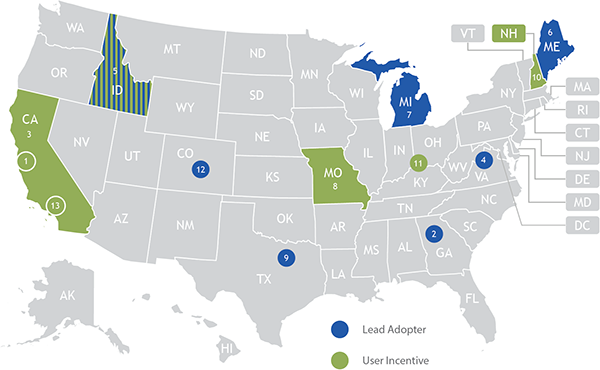
Locations of IAP recipients.
Blue color indicates Lead Adopter and green color shows User Incentive.
- Association of Monterey Bay Area Governments
- Atlanta Regional Commission
- California Department of Transportation
- Charlottesville-Albemarle Metropolitan Planning Organization
- Idaho Department of Transportation
- Maine Department of Transportation
- Michigan Department of Transportation
- Missouri Department of Transportation
- North Central Texas Council of Governments
- New Hampshire Department of Transportation
- Ohio-Kentucky-Indiana Regional Council of Governments
- Pikes Peak Area Council of Governments
- Southern California Association of Governments
Overview
The IAP provides two types of funding assistance to help State DOTs and MPOs apply and integrate Eco-Logical principles in their activities:
- Lead Adopter assistance (up to $250,000) supports agencies that have completed early steps of the Eco-Logical approach, including agencies with existing collaborative partnerships that have developed or used REFs.
- User Incentive assistance (up to $25,000) encourages agencies that have interest, though not necessarily prior experience, in adopting Eco-Logical into their organizations.
IAP Recipient Progress
During 2014/2015, IAP recipients actively worked on their projects and deliverables.
- As of July 2015, five IAP projects are complete.
- Six of the remaining nine projects are scheduled to be complete by December 2015, with the final three anticipated in 2016.
- Collectively, IAP recipients will complete 115 deliverables.
- These deliverables include data-sharing agreements and Memoranda of Understanding, final reports, and online data tools and platforms.
- As of July 2015, 50 deliverables (44%) are complete.
IAP recipients have completed a range of products and activities to date, including:
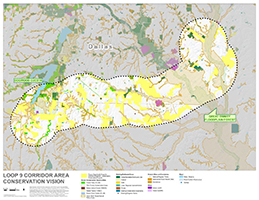
Data collection, maps, and REFs,
such as the one shown above by the
North Central Texas Council of Governments;
|
|
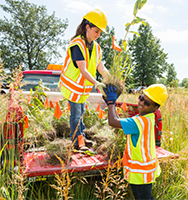
Partnerships with existing and new stakeholders,
such as Michigan DOT’s partnership
with the Michigan Department of Natural Resources;
|
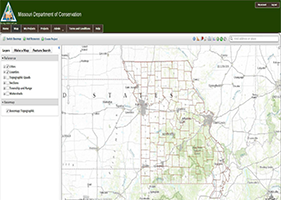
Websites of mapped and compiled data,
such as Missouri DOT’s work to improve
the Natural Heritage Review website; and
|
|
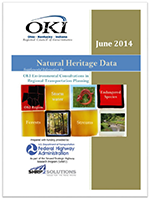
Final reports with documentation of
methodologies and lessons learned,
such as the Ohio-Kentucky-Indiana
Regional Council of Governments’ final report.
|
Status of IAP Performance Measures as of July 2015
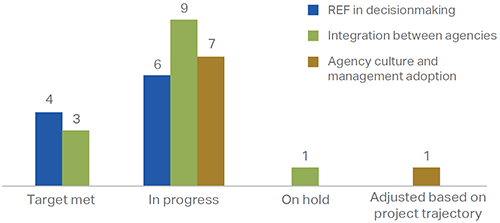
IAP Performance Measures
Agencies that are implementing Eco-Logical have consistently reported the need for measurable benefits of the approach, in part to make a business case for Eco-Logical among their leadership and with partners.
FHWA uses performance measures to track the measurable benefits of IAP projects. FHWA tracks performance measures in three focus areas:
- Use of the REF and data tools in the decisionmaking process within an organization
- Integration of planning and decisionmaking between agencies
- Incorporation of the Eco-Logical approach into the management and culture of an organization
In the initial kick-off stages of their projects, IAP recipients identified the performance measures they wished to use. Lead Adopter recipients selected one performance measure in each of the three focus areas. User Incentive recipients identified a minimum of one measure. In total, IAP recipients selected 31 performance measures.
As of July 2015, of the 31 performance measures initially identified:
- 10 relate to “REF in decisionmaking,” of which 4 are complete.
- 13 relate to “Integration of planning and decisionmaking,” of which 3 are complete.
- 8 relate to “Agency culture and management adoption,” of which 0 are complete.



Implementation Resources
FHWA and AASHTO have launched several products related to Implementing Eco-Logical and/or the FHWA Eco-Logical Program. Here are a few examples of the activities to date:
Starter Kit
Eco-Logical Starter Kit Visits by Month
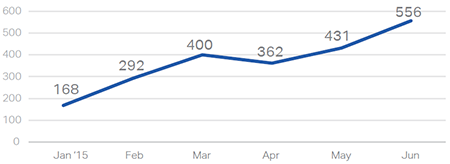
FHWA released the Eco-Logical Starter Kit in January 2015.
The Starter Kit offers an overview of the nine steps of the IEF and provides real-life examples of agencies applying these steps.
The Starter Kit includes research products, reports, case studies, and more. Since its release, visits to the FHWA Eco-Logical website have tripled (refer to the graph to the right).
Practitioner’s Handbook
The handbook, currently in development, introduces approaches to applying Eco-Logical in a simplified format consistent with existing AASHTO Center for Environmental Excellence handbooks.
The handbook will describe each step of the IEF, along with goals, strategies, and roles for agencies to implement each step.
Case Studies
The Eco-Logical case studies highlight how transportation agencies are implementing the nine steps of the IEF. Each case study documents an agency’s achievements and challenges as it applies the Eco-Logical approach in its region or State. FHWA delivered two case studies in 2015, featuring:
Other Eco-Logical Program Activities + Resources
Number of Webinar Participants
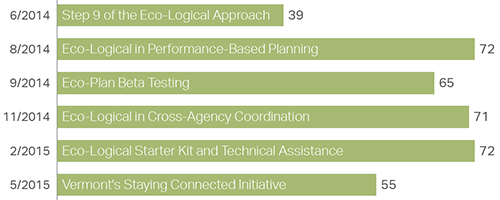
Webinar Participation by Agency Type

Eco-Logical Webinar Series
As part of FHWA’s Eco-Logical Program, FHWA offers bi-monthly webinars. Topics range from the IEF’s nine steps to examples of Eco-Logical in practice and related initiatives.
The audience for the one-hour webinars often includes Implementing Eco-Logical IAP recipients, transportation agency practitioners, FHWA environmental staff, partner Federal agencies, State and regional resource agencies, academic researchers, and NGOs.
Over half of webinar participants are transportation practitioners that seek relevant applications of Eco-Logical in practice.
In 2014/2015, FHWA presented 6 webinars to more than 370 participants.
Signatory Agency Coordination
Signatory Agency
Eco-Logical
Initiatives
In leading Implementing Eco-Logical activities and through coordination with the Signatory Agencies, FHWA recognizes that agencies may often organize or participate in activities that align with the principles of Eco-Logical. These initiatives, sometimes known under different names, may include:
- Landscape conservation cooperatives
- Inventory and monitoring programs
- Watershed approach
- Eco-regional assessments
- Integrated ecosystem assessment approach
- Landscape approach
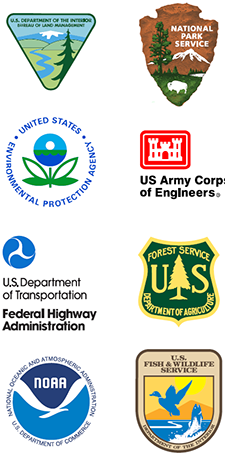
Logos of the Eco-Logical Signatory Agencies (clockwise, from left): BLM, NPS, USACE, USFS, USFWS, NOAA, FHWA, and EPA.
Representatives from eight Federal agencies (the “Signatory Agencies”)—Bureau of Land Management, FHWA, National Oceanic and Atmospheric Administration, National Parks Service, U.S. Army Corps of Engineers, U.S. Environmental Protection Agency, U.S. Fish and Wildlife Service, and U.S. Forest Service—affirmed their commitment to Eco-Logical in 2006 by developing and endorsing Eco-Logical: An Ecosystem Approach to Developing Infrastructure Projects.
FHWA continues to support collaboration among the Signatory Agencies, including through bi-annual in-person meetings. These meetings focus on continued implementation and cross-agency support of the Eco-Logical approach or other agency initiatives under the Eco-Logical umbrella. FHWA hosted two meetings in 2014/2015, in July 2014 and January 2015.
The Signatory Agencies are currently working on activities for the 10th anniversary of Eco-Logical in 2016.
Executive Actions Related to Eco-Logical
Efficient processing of environmental reviews and permits at the Federal level can help expedite the delivery of large-scale infrastructure projects while ensuring that design and construction protect environmental and community resources. Since 2011, the Obama Administration has issued several presidential memoranda and executive orders to establish methods designed to reduce review and permitting periods and increase transparency.
Presidential Memorandum
Speeding Infrastructure Through More Efficient and Effective Permitting and Environmental Review
On August 31, 2011, President Obama issued a memorandum that focuses on the role of environmental review and permitting processes in maintaining standards for infrastructure development that supports public health, safety, and the environment. The memorandum sets forth that the Federal government shall serve as an active party in establishing a Federal Infrastructure Permitting Dashboard to help advance projects with significant economic development and job creation potential through the environmental planning and permitting stages while promoting accountability and transparency.
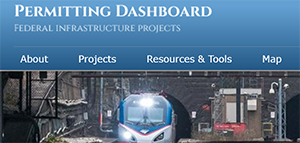
Screenshot of the Federal Infrastructure Permitting Dashboard
Executive Order
Improving Performance of Federal Permitting and Review of Infrastructure Projects
On March 22, 2012, the White House issued Executive Order (EO) 13604 to further help expedite Federal permitting and review processes for infrastructure projects while improving environmental and economic benefits. The EO expanded projects under the Dashboard to include those of National or regional significance.
Presidential Memorandum
Modernizing Federal Infrastructure Review and Permitting Regulations, Policies, and Procedures
Building on the earlier efforts, on May 17, 2013, the President delivered a memorandum that directed the development of an implementation plan to institutionalize best management practices, leverage web-based technologies for information-sharing, and encourage opportunities for stakeholder engagement and public input.
Published in May 2014, the Implementation Plan offers strategies and reforms for expediting review and permitting processes, such as the expanded use of the Dashboard. Today, the Federal government continues to deliver on the strategies discussed in the Implementation Plan.
Other Federal Initiatives Relating to Eco-Logical
Planning and Environmental Linkages
The Eco-Logical approach is closely linked to FHWA’s Planning and Environment Linkages (PEL) initiative.
PEL is a collaborative and integrated approach to transportation decision-making that:
- considers environmental, community, and economic goals early in the transportation planning process, and
- uses the information, analysis, and products developed during planning to inform the environmental review process.
Eco-Logical could, for example, be used to address the biological components of a PEL program.
PlanWorks
PlanWorks is a SHRP2 Solution that includes the Eco-Logical approach as part of its web-based decision support tool for collaborative decisionmaking in transportation planning and project development.
PlanWorks is built around key decision points in long-range planning, programming, corridor planning, and environmental review. PlanWorks suggests when and how to engage cross-disciplinary partners and stakeholder groups. This system can help build consensus throughout these processes.
Turner-Fairbank Implementing Eco-Logical Program Evaluation
The FHWA Turner-Fairbank Highway Research Center is currently leading an effort to evaluate its research and technology (R&T) development program and the selection and use of R&T funded research, including funds provided to the SHRP2 Implementing Eco-Logical Program.
The Implementing Eco-Logical evaluation will investigate the effect of FHWA R&T activities on the knowledge and implementation of the Eco-Logical approach (i.e., ecosystem-based infrastructure planning and mitigation) to transportation decisionmaking (i.e., transportation planning, project development, and environmental mitigation) by State DOT and MPO decisionmakers.
Return to Table of Contents ↑
Return to Top ↑
- PART ONE
- PART TWO
- PART THREE
Part 2: Findings and Recommendations
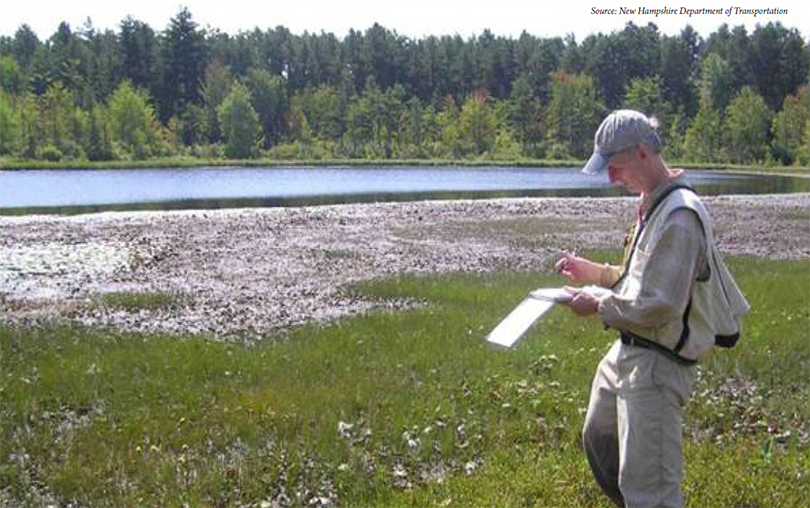
Source: New Hampshire Department of Transportation
Overview
The experiences of the 13 IAP recipients help FHWA monitor the state of the practice of Eco-Logical, identify noteworthy practices and lessons learned, develop recommendations for agencies implementing the approach, and recognize potential opportunities for future support as part of the FHWA Eco-Logical Program.
This section summarizes findings from the 13 IAP recipients from June 2014 through July 2015 and provides applicable recommendations for agencies interested in applying Eco-Logical and for FHWA in advancing its Eco-Logical Program.
Methodology
FHWA tracks the progress of IAP recipients through mid-year reports and annual telephone discussions.
In December 2014, FHWA asked each IAP recipient to complete a written progress report to collect updates on project status, performance measures, and deliverables.
In March 2015, FHWA conducted one-hour-long teleconference calls with the IAP recipients to obtain updates, insights, and lessons learned relating to the IAP projects.
In July 2015, IAP recipients provided written updates on project status and deliverables.
Findings and Recommendations
The findings and recommendations discussed in this report fall into four categories (see table at right):
- Building and Sustaining Partnerships
- Institutionalizing Eco-Logical into Agency Practices
- Quantifying and Communicating Results
- Developing Data, Tools, and Strategies
Through these findings, FHWA seeks to strengthen knowledge of Eco-Logical and its uses, the opportunities and benefits it provides, and the challenges practitioners face to help guide both agencies in implementation and future activities of the FHWA Eco-Logical Program.
Findings and Recommendations from the 2014/2015 Implementing Eco-Logical Annual Report
| Category |
Findings |
Recommendations for Agencies Implementing Eco-Logical |
Recommendations for FHWA |
- Building and Sustaining Partnerships
|
1.1 |
Agencies implementing Eco-Logical recruit partners early in the process. |
- Engage agency partners early in the process, and listen to their needs.
- Develop tailored messages to demonstrate the benefits that Eco-Logical brings to a particular stakeholder group.
- Think of agency relationships as a long-term investment, rather than a project-specific commitment.
- At the beginning of a project, work with stakeholders to clarify expectations for time commitments and develop a coordination plan that works for all parties.
|
- Continue to promote existing FHWA materials that practitioners can use to educate partners about Eco-Logical, such as the Eco-Logical Starter Kit.
|
| 1.2 |
IAP recipients use a variety of methods to promote consistent stakeholder engagement while respecting partners’ time constraints.
|
| 1.3 |
Successful relationships established through IAP projects carry over into other projects, lay the groundwork for future collaboration, and result in new opportunities for streamlining. |
- Institutionalizing Eco-Logical into Agency Practices
|
2.1 |
In many cases, IAP project leads serve as “champions” for promoting Eco-Logical within their agency and building institutional knowledge. |
- Look for opportunities to formally or informally educate agency staff about Eco-Logical.
- Document internal processes for implementing Eco-Logical to facilitate knowledge transfer when there is staff turnover.
- When possible, use signed agreements to institutionalize roles and protocols.
- Look for opportunities to integrate Eco-Logical into other agency initiatives, including regular long-range transportation plan updates.
- Recruit high-level champions.
|
- Distribute a template presentation or other outreach materials on Eco-Logical that agencies can use internally to educate staff and senior leadership.
- Explore ways to promote Eco-Logical among senior leadership at transportation agencies.
|
| 2.2 |
Formal agreements, such as memoranda of agreement or memoranda of understanding, can help promote long-term implementation of Eco-Logical by formalizing commitments and providing an institutional framework that is more resilient to shifting priorities and staffing changes. |
| 2.3 |
One way for agencies to support the long-term use of the Eco-Logical approach is to build connections with related initiatives within the agency. |
| 2.4 |
Support for Eco-Logical at the leadership level makes it much easier to institutionalize Eco-Logical into agency practices and ensure long-term implementation. |
- Quantifying and Communicating Results
|
3.1 |
Quantifying the benefits of applying the Eco-Logical approach—based on cost, time, or other savings—continues to be a challenge for agencies implementing Eco-Logical. |
|
- Continue to explore how best to support agencies in making a business case for Eco-Logical and in demonstrating quantifiable benefits.
|
- Developing Data, Tools, and Strategies
|
4.1 |
Eco-Logical data and tools are most effective when tailored to the region’s goals, priorities, and constraints. |
- Work with partners to ensure that transportation and conservation data inputs reflect regional realities and priorities.
|
- Continue to support tools that simplify the creation of an REF for MPOs that have limited GIS capacity.
- Continue to work with individual agencies to provide customized technical assistance and subject matter expertise.
|
| 4.2 |
Some technical aspects of Eco-Logical, such as creating an REF or setting up a mitigation crediting program, require a level of specialized expertise that may present a barrier to entry for some agencies. |

Category 1: Building and Sustaining Partnerships
As noted in previous years’ Eco-Logical annual reports, strong partnerships with external stakeholders are key to successful implementation of the Eco-Logical approach. All IAP recipients emphasized the importance of relationships to the ultimate success of their Eco-Logical projects, and several recipients cited improved relationships as the most valuable and useful outcome of their IAP projects. The following findings demonstrate how IAP recipients have been able to translate early coordination efforts into continuing and long-standing partnerships.
Finding 1.1: Agencies implementing Eco-Logical recruit partners early in the process.
Explanation
Engaging partners early helps ensure that an agency’s implementation of Eco-Logical reflects shared regional priorities and that the work products—for example, an REF or advanced mitigation strategy—will be useful for all stakeholders.
It may take time to cultivate new relationships and engage partners. Some later steps of Eco-Logical, such as establishing a programmatic consultation, require an upfront investment of time and resources. Stakeholder agencies may be hesitant to commit, particularly if it is unclear what the specific benefits may be for them. Targeted messages and early coordination can help encourage buy-in.
Supporting Example
In beginning its IAP User Incentive project, the Missouri Department of Transportation (MoDOT) partnered with the Missouri Department of Conservation (MDC) to conduct stakeholder outreach to partner agencies as part of its effort to improve the sharing of natural resource information on the MDC Natural Heritage Review website. MoDOT and MDC’s close coordination, further formalized by a Memorandum of Agreement (MOA) between the two agencies, helped facilitate four stakeholder meetings to collect feedback on needed website updates, identify shared priorities among the partners, and establish best management practices to protect threatened and endangered species from impacts.
Recommendations
Recommendation for agencies implementing Eco-Logical:
- Engage agency partners early in the process, and listen to their needs.
- Develop tailored messages to demonstrate the benefits that Eco-Logical brings to a particular stakeholder group.
Recommendation for FHWA:
- Continue to promote existing FHWA materials that practitioners can use to educate partners about Eco-Logical, such as the Eco-Logical Starter Kit.
Finding 1.2: IAP recipients use a variety of methods to promote consistent stakeholder engagement while respecting partners’ time constraints.
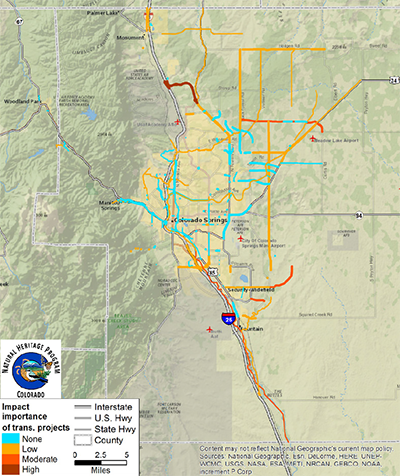
Working with its partners, PPACG mapped the impact importance of transportation projects in the Colorado Springs region (shown above). Source: PPACG
Explanation
After partners have agreed to participate, regular coordination and meetings with partner agencies are essential to ensure that application of the Eco-Logical approach is consistent and that data and tools reflect shared priorities, even as those priorities change.
IAP recipients often face a delicate balance between maintaining a high level of engagement and overburdening partners with extended demands on their time.
By working together early on in the project process, IAP recipients have found innovative ways to build and sustain partners’ involvement such as offering alternatives to in-person attendance at meetings, presentations to agency leadership, and continued outreach and support to partners to share information on IAP projects and identify opportunities for future activities.
Supporting Example
In their projects, IAP recipients have used a variety of techniques to avoid stakeholder fatigue, including limiting the number of meetings that were absolutely necessary, structuring project timelines to accommodate partners’ schedules, and providing opportunities for remote participation to reduce travel times.
The Pikes Peak Area Council of Governments’ (PPACG) IAP Lead Adopter project involved 19 agencies and organizations, all of whom had limited schedules and varying availabilities. To maximize participation in its stakeholder meetings, PPACG offered web-based remote participation options, allowing stakeholders located several hours away to participate conveniently.
Recommendations
Recommendation for agencies implementing Eco-Logical:
- At the beginning of a project, work with stakeholders to clarify expectations for time commitments and develop a coordination plan that works for all parties.
Finding 1.3: Successful relationships established through IAP projects carry over into other projects, lay the groundwork for future collaboration, and result in new opportunities for streamlining.
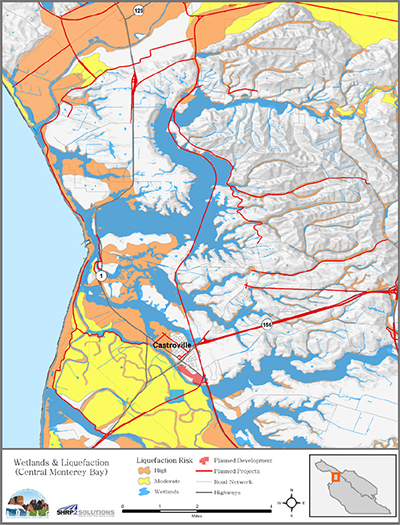
AMBAG’s IAP User Incentive project involved compiling and mapping sensitive resources, such as the map of wetlands and liquefaction shown above. Source: AMBAG
Explanation
IAP recipients reported that their projects strengthened personal connections, built institutional knowledge about how to partner effectively, and established a track record of successful collaboration—all factors that facilitate future implementation of the Eco-Logical approach and generate positive impacts that extend beyond the scope of the original IAP projects.
Even when stakeholder agencies are ultimately not able to fully accommodate requests to share data or formalize partnerships, the process—of establishing agency points of contact, learning about partners’ priorities and constraints, and discussing landscape-level integration of infrastructure and conservation planning—can lay the groundwork for future efforts.
Supporting Examples
The California Department of Transportation (Caltrans) found that the lines of communication established during its IAP project have allowed its newly created Highway Stewardship Teams—interagency teams dedicated to reducing animal/vehicle collisions in Northern and Southern California—to respond quickly to opportunities for grant funding to improve wildlife connectivity.
While the Association of Monterey Bay Area Governments (AMBAG) was not able to obtain archaeological resource data due to data sensitivity concerns, its initial request to the California Office of Historic Preservation sparked a useful dialogue between the two agencies on how this type of data could be used more effectively in transportation planning and project delivery in the future.
Recommendations
Recommendation for agencies implementing Eco-Logical:
- Think of agency relationships as a long-term investment, rather than a project-specific commitment.
Category 2: Institutionalizing Eco-Logical into Agency Practices
As the IAP recipients complete their IAP projects, they face new challenges in leveraging the progress made and lessons learned beyond the projects’ duration. Ensuring that an agency continues to implement the Eco-Logical approach requires maintaining staff knowledge, formalizing commitments, and fostering connections between Eco-Logical and existing programs. Institutionalizing Eco-Logical into an agency’s internal processes and procedures requires high-level knowledge and support of the Eco-Logical approach agency-wide and at management levels.
Finding 2.1: In many cases, IAP project leads serve as “champions” for promoting Eco-Logical within their agency and building institutional knowledge.
Explanation
IAP recipient project leads increase agency awareness by holding lunch-and-learns or other informational sessions, sharing updates at staff meetings, and presenting results to their State DOT or MPO leadership and boards.
As Eco-Logical practitioners, the IAP recipient project leads have a strong understanding of Eco-Logical at the application and implementation levels, which they often leverage to demonstrate project-specific and overall benefits to managers and agency leadership.
Supporting Examples
Increasing awareness of Eco-Logical within an agency is important because, when an agency’s expertise about Eco-Logical rests in just one staff member, it is more vulnerable to disruption if that person leaves the agency or changes roles.
For many of the IAP projects, IAP project leads have worked to build a team of several staff to facilitate the transfer of Eco-Logical knowledge across project teams, divisions, and departments.
Recommendations
Recommendation for agencies implementing Eco-Logical:
- Look for opportunities to formally or informally educate agency staff about Eco-Logical.
- Document internal processes for implementing Eco-Logical, to facilitate knowledge transfer when there is staff turnover.
Recommendation for FHWA:
- Distribute a template presentation or other outreach materials on Eco-Logical that agencies can use internally to educate staff and senior leadership.
Finding 2.2: Formal agreements, such as MOAs or MOUs, can help promote long-term implementation of Eco-Logical by formalizing commitments and providing an institutional framework that is more resilient to shifting priorities or staffing changes.
Explanation
In addition to their benefits for establishing data-sharing protocols and kick-starting dialogue with partner agencies, signed agreements can provide a framework for continued implementation of Eco-Logical, including after the completion of an IAP project.
These agreements help ensure partners’ long-term involvement in Eco-Logical as well as formalize the agencies’ commitment to Eco-Logical. For example, having the transportation agency commitment in place and known to partners can further help to increase awareness of Eco-Logical over time and continue to build connections.
Supporting Examples
Of the 13 IAP recipients, 4 have signed agreements with partners as part of their IAP projects, and 4 more are making progress towards signed agreements. Many of these agreements describe commitments, roles, and protocols for how two or more agencies will implement a particular aspect of Eco-Logical.
For example, as part of its IAP User Incentive project, the Idaho Transportation Department (ITD) updated an existing MOU with the Idaho Department of Fish and Game (IDFG) to include new protocols for data-sharing and interagency coordination between transportation planning and wildlife management. The agreement has led the way for implementation of these protocols under the ITD-IDFG IAP Lead Adopter project.
Recommendations
Recommendation for agencies implementing Eco-Logical:
- When possible, use signed agreements to institutionalize roles and protocols.
Finding 2.3: One way for agencies to support the long-term use of the Eco-Logical approach is to build connections with related initiatives within the agency.
Explanation
Incorporating the Eco-Logical approach into existing agency programs and initiatives is an efficient way to demonstrate the relevance of the Eco-Logical approach and promote long-term agency adoption.
Tying Eco-Logical principles to updates for a long-range transportation plan (LRTP) can help bring in environmental considerations as part of the project prioritization process and further integrate the Eco-Logical approach into “traditional” transportation planning practices. For example, the REF can be used as a quantitative performance measure for evaluating transportation projects for inclusion in the LRTP.
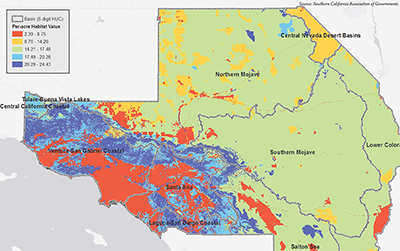
As part of its IAP User Incentive project, SCAG developed a framework for assessing conservation and habitat value. Source: SCAG
Supporting Example
The Southern California Association of Governments (SCAG) used its IAP User Incentive project to develop a regional open space database and a methodology for identifying conservation priority areas.
Building off of its IAP project, SCAG convened an Open Space Conservation Working Group to develop recommendations for how it should address conservation and mitigation in the next update of its Regional Transportation Plan (RTP).
By connecting the outcomes of its IAP project to its RTP, SCAG was more effectively able to tie landscape-level conservation and mitigation planning into its transportation planning activities.
Recommendations
Recommendation for agencies implementing Eco-Logical:
- Look for opportunities to integrate Eco-Logical into to other agency initiatives, including regular LRTP updates.
Finding 2.4: Support for Eco-Logical at the leadership level makes it much easier to institutionalize Eco-Logical into agency practices and ensure long-term implementation.
Explanation
Leadership-level “champions” can effectively support long-term implementation of Eco-Logical through each of the three strategies discussed earlier: building institutional knowledge of the Eco-Logical approach, supporting formalized commitments to implementing Eco-Logical, and identifying and promoting connections to existing agency programs.
Supporting Example
Vocal support from senior leadership at the Maine Department of Transportation (MaineDOT) is leading to advancement of a programmatic agreement with USFWS on Atlantic salmon. Leadership-level champions at MaineDOT have also promoted efforts to document MaineDOT’s internal process workflows and identify interagency connections to Eco-Logical.
Recommendations
Recommendation for agencies implementing Eco-Logical:
- Recruit high-level champions.
Recommendation for FHWA:
- Explore ways to promote Eco-Logical among senior leadership at transportation agencies.

MaineDOT’s programmatic agreement on Atlantic salmon is designed to help expedite the delivery of transportation projects in the State and follow an agreed-upon and predictable process (see above). Source: MaineDOT
Category 3: Quantifying and Communicating Results
Some steps of the Eco-Logical approach, such as creating an REF or establishing a programmatic agreement, require a short-term investment of resources upfront but can save time and money later in transportation project development or planning processes. In an era of fiscal constraint and declining transportation revenues, agencies may face challenges in setting aside or justifying start-up funding for implementing the Eco-Logical approach. In this context, staff champions of Eco-Logical may be requested to make a “business case” for the Eco-Logical approach by demonstrating that the long-term benefits of Eco-Logical outweigh its costs.
Finding 3.1: Quantifying the benefits of applying the Eco-Logical approach—based on cost, time, or other savings—continues to be a challenge for agencies implementing Eco-Logical.
Explanation
Although IAP recipients observed anecdotal evidence of Eco-Logical’s benefits, none has comprehensively attempted to quantitatively measure the effects of the Eco-Logical approach on schedule or budget. In many cases, constraints on resources, funding, time, or expertise may limit staff’s availability to perform these types of in-depth analyses.
All IAP recipients recognized the importance of quantitative measures, but many emphasized the difficulty of quantifying avoided costs.
Supporting Examples
As the IAP recipients complete their projects, leverage IAP project findings into new projects, and continue to apply the Eco-Logical approach in their agencies, they will likely have more opportunities to track how the approach affects schedule and budget throughout a project lifecycle.
Examples of how other agencies have implemented Eco-Logical may also serve as a starting point for engaging agency leadership in a discussion about the potential benefits of Eco-Logical for a specific project, corridor, or region.
Recommendations
Recommendations for FHWA:
- Continue to explore how best to support agencies in making a business case for Eco-Logical and in demonstrating quantifiable benefits. Possible ideas include:
- Expand on existing research sponsored by FHWA on how to quantify the benefits of Eco-Logical.
- Develop one-page summaries of how agencies are implementing Eco-Logical and the types of benefits that they are seeing.
- Distribute case studies on how agencies have made the business case for Eco-Logical.
- Provide funding for agencies to track the quantitative benefits of Eco-Logical.
Category 4: Developing Data, Tools, and Strategies
From REFs to advanced mitigation strategies, data and tools that support landscape-level decision-making are at the core of the Eco-Logical approach. In previous years’ annual reports, IAP recipients noted many challenges related to data. Based on the results of this reporting year, recipients have resolved many of these challenges through their efforts.
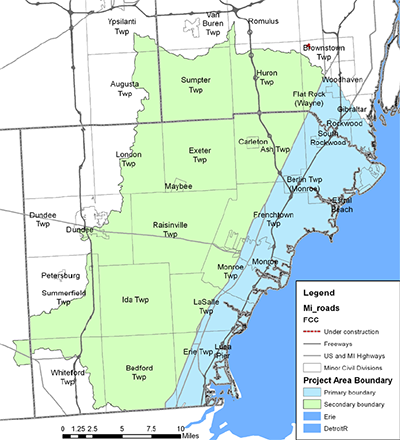
In addition to the conservation targets, MDOT established a Technical Advisory Committee to help develop its REF and determine the IAP project boundaries (shown above). Source: MDOT
Finding 4.1: Eco-Logical data and tools are most effective when tailored to the region’s goals, priorities, and constraints.
Explanation
Eco-Logical products—including REFs, conservation priority sites, or advanced mitigation plans—are only as good as the data used to create them. Data that may be crucial in one region, such as salmon habitat, may be less relevant in another. IAP recipients are working with stakeholders to tailor data collection and analysis efforts to fit regional needs.
In many cases, agencies use the nine-step IEF promoted by Eco-Logical as a starting point. Agencies can then adapt available data and tools to meet their goals for a particular project or get a more holistic perspective of the region’s ecological resources and transportation priorities.
Supporting Examples
The Michigan Department of Transportation (MDOT) worked with stakeholders to select seven regionally important conservation targets—coastal tributaries, inland wetlands, wildlife connectivity, globally rare natural communities, aerial migrants, migratory fish, and bats—that will guide its REF and Conservation Action Plan.
In order to make sure its REF accurately reflected planned transportation projects in the Pikes Peak region, PPACG reached out to local partners to include data on locally and privately funded transportation projects. The resulting REF will include more than 300 proposed transportation projects—including those that receive no Federal-aid funding.
Recommendations
Recommendation for agencies implementing Eco-Logical:
- Work with partners to ensure that transportation and conservation data inputs reflect regional realities and priorities.
Finding 4.2: Some technical aspects of Eco-Logical, such as creating a REF or setting up a mitigation crediting program, require a level of expertise that may present a barrier to entry for some agencies.
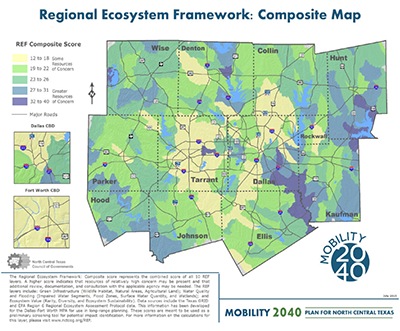
NCTCOG’s REF, updated as part of its IAP Lead Adopter project, combines environmental and transportation considerations and will help guide next steps for the SVM effort. Source: NCTCOG
Explanation
Smaller MPOs that lack advanced GIS analysis skills or sufficient staff capacity may find creation of an REF daunting. Setting up a mitigation banking program requires technical knowledge of ecosystem services and crediting options, areas of expertise that many transportation agencies may not have in-house.
While examples of successful implementations from other regions can be helpful as models, each region has a unique combination of ecological, regulatory, and political factors that requires a tailored approach. Consequently, building a team with the required expertise and capacity is extremely helpful for implementation of the more technical aspects of Eco-Logical. This expertise can come from within an agency or from other external, public or private sector sources.
Supporting Examples
The North Central Texas Council of Governments (NCTCOG) noted the importance of outside subject-matter experts on environmental science and mitigation programs to advance the design of its Shared Value Mitigation (SVM) Pilot Program.
All of the IAP recipients represent State DOTs and MPOs that have significant technical capacity in-house, or that have connected with partners or consultants who provide the needed resources or expertise for implementation of the IAP projects. The varying scopes of the IAP User Incentive and Lead Adopter projects demonstrate how technical knowledge might be applied at different levels of effort. However, steps like advanced mitigation may still pose a challenge.
Recommendations
Recommendations for FHWA:
- Continue to support tools that simplify creation of an REF for MPOs that have limited GIS capacity.
- Continue to work with individual agencies to provide customized technical assistance and subject-matter expertise.
Conclusion
The 2014/2015 Implementing Eco-Logical Program Annual Report showcases the accomplishments of the Implementing Eco-Logical Program as well as of the 13 IAP recipients. With many activities now complete or in progress, FHWA, AASHTO, and the IAP recipients have had a productive year in releasing program materials and resources, and project-related deliverables.
Focus on Technical Assistance
For the Implementing Eco-Logical Program, the 2014/2015 report cycle represented a strong focus on technical assistance. With several peer exchanges and workshops completed and others already on the horizon for the 2015/2016 period, FHWA and AASHTO plan to continue this technical assistance focus over the coming year to offer additional opportunities for peer information-sharing.
New Implementing Eco-Logical Resources
New resources such as the Practitioner’s Handbook will provide written references for agencies seeking information on Eco-Logical’s nine-step approach and on how peers effectively applied these steps.
The results from the IAP projects captured in this report further demonstrate the successes these State DOTs and MPOs have found in implementing Eco-Logical. The findings showcase practices that the IAP recipients have found useful throughout their work as well as serve as the basis for suggestions on how other agencies might take similar approaches.
Upcoming Activities
Project findings indicate areas of opportunity for the FHWA Eco-Logical Program in the future—from developing tailored stakeholder messages to formalizing partnerships to helping agencies demonstrate quantifiable benefits. Over the coming year, FHWA will continue to work with the IAP recipients to gather information on final conclusions and project results as the IAP projects come to a close to help guide future Eco-Logical Program activities.
Return to Table of Contents ↑
Return to Top ↑
- PART ONE
- PART TWO
- PART THREE
Part 3: Appendices

Source: Southern California Association of Governments
Appendices
Implementation Assistance Program (IAP) Project Summaries
Lead Adopter Incentives IAP Project Summaries

Atlanta Regional Commission (ARC)
Developing a REF for the Proctor Creek Environmental District
Schedule: June 2013-Dec 2015. Total cost: $250,000.
Project Goals
ARC is developing and implementing a Regional Ecosystem Framework (REF) and creating a strategic framework for the Proctor Creek Environmental District (PCED)—a key watershed in the Atlanta metropolitan area—in order to expand the types of ecological and economic data used for prioritizing new transportation projects in the region.
Process
ARC convened a stakeholder committee to facilitate coordination with partners, and hired a consultant to study the fiscal, economic, and environmental effects of implementing a REF near a central business district. ARC also tested methodologies for inclusion in a decision support tool, a component of the strategic framework, which will help guide infrastructure investment in the PCED over the next few decades.
Recent Activities and Accomplishments
- Held internal and external Proctor Creek stakeholder meetings to coordinate and prioritize information needs with participants from the City of Atlanta, Federal Highway Administration, U.S. Environmental Protection Agency, Metro Water District, and other non-governmental organizations, among others.
- Hired a consultant to complete a market economic analysis in the PCED to analyze the links between economic development and environmental resources. As part of this activity, ARC is looking to draw linkages and connections between economic development and environmental outcomes such as watershed restoration.
- Began analyzing previous project prioritization selection methods to determine gaps that should be included in the decision support tool.
Future Steps
- Continue to compile economic and environmental information and use it to inform the PCED REF.
- Meet with Federal and State project partners to review data from the study and reaffirm the commitment to linking economic factors with environmental considerations in the REF.
- Use the REF data to create draft maps and decision criteria for inclusion in ARC’s future regional transportation plans.
- Determine the feasibility of placing updated REF data online, which would make the data more accessible to project partners.
- Explore partnering with the Atlanta University Center (AUC) to provide technical assistance as part of the development of the AUC/Vine City English Avenue Eco-District, which is wholly contained within the Proctor Creek watershed.
Insights on Eco-Logical
- Effective early communication with stakeholders is important to leverage existing knowledge and share information. ARC worked closely with the Proctor Creek Community Group early on in the project, participating in meetings and incorporating feedback into deliverables.
- Eco-Logical has created opportunities for ARC staff from different departments to collaborate, allowing the agency’s specialists in transportation, land use, and Geographic Information Systems to develop a more holistic view of projects.
Return to Project Summaries List ↑

Charlottesville-Albemarle Metropolitan Planning Organization (CA-MPO)
Testing Application of an Existing REF in Transportation Projects and Conservation Prioritization
Schedule: July 2013-January 2015. Total cost: $250,000.
Project Goals
Through its IAP Lead Adopter project, CA-MPO is advancing project alternatives for the Free Bridge Area Congestion Relief Project to alleviate significant congestion issues on the US-250 Crossing of the Rivanna River in Virginia.
Process
CA-MPO convened a stakeholder committee to identify and rank project alternatives, and used its existing Regional Ecosystem Framework (REF) to establish a weighted ranking system for evaluating each alternative’s environmental impacts.
Recent Activities and Accomplishments
- Organized 3 meetings with 33-member stakeholder committee, facilitated by a neutral third-party, which resulted in a weighted, REF-based ranking system and identification of 2 preferred transportation alternatives.
- Added the stakeholder committee’s preferred alternatives to the CA-MPO’s Visioning List of its long-range transportation plan (LRTP). The Visioning List is used by CA-MPO to identify important regional projects and priorities for either future inclusion on its constrained project list or to prioritize for State transportation funding.
- Reached an agreement with the Virginia Department of Transportation (VDOT) Culpeper District to endorse the use of the REF as a planning and decision support tool for transportation project development within CA-MPO.
Future Steps
- Coordinate with VDOT to formalize agency’s endorsement of Eco-Logical and work with VDOT contacts and support staff to ensure that the Eco-Logical REF tool is used during the development of transportation project alternatives within CA-MPO.
- Update the CA-MPO website to include its REF tool, user guide, and instructional presentation in order to promote use of the REF by local governments.
- Develop a training module on Eco-Logical and the REF tool for staff at VDOT, other metropolitan planning organizations, and local jurisdictions.
- Prepare a report that documents how the Eco-Logical approach and REF satisfy Virginia’s statewide requirement for transportation agencies to use environmental performance measures.
Insights on Eco-Logical
- An independent facilitator who is trusted by the community can make the stakeholder engagement process more legitimate and productive.
- The REF is a versatile tool that can support decisionmaking at various stages of the transportation planning process.
Return to Project Summaries List ↑

Idaho Transportation Department (ITD)
Coordinating Transportation Planning and Wildlife Management
Schedule: June 2013-March 2016. Total cost: $275,000.
Project Goals
ITD is working with the Idaho Department of Fish and Game (IDFG) to implement data-sharing protocols and develop Species of Greatest Conservation Need (SGCN) data layers in order to improve interagency coordination, streamline transportation project development, and facilitate stewardship of natural resources. ITD received $25,000 in User Incentive and $250,000 in Lead Adopter funding.
Process
For its User Incentive project, ITD updated its Memorandum of Understanding (MOU) with IDFG to include new protocols for data-sharing and interagency coordination between transportation planning and wildlife management. For the Lead Adopter project, ITD and IDFG developed a web service that allows ITD to view real-time IDFG data in IPLAN, ITD’s cloud-based portal for spatial data. ITD and IDFG are also developing SGCN data layers to help support transportation project development and reduce wildlife impacts.
To prepare for the Lead Adopter activity, ITD started coordinating with GIS practitioners within the agency to determine the feasibility of the proposed IPLAN improvements. IDFG is updating its fish and wildlife data, including its State wildlife action plan and other relevant geospatial layers, and developing data delivery applications.
Recent Activities and Accomplishments
- Held 3 stakeholder workshops to inform the development of the MOU, which were attended by approximately 125 staff from ITD, IDFG, and Federal partner agencies.
- Executed an MOU with IDFG for improved data-sharing and interagency coordination.
- Established metadata standards for shared datasets.
- Developed a secure web service that enables ITD to access IDFG data and view in IPLAN.
- Began delivery of SGCN datasets.
Future Steps
- Refine existing IDFG data layers to improve usability in IPLAN and make data more accessible.
- Complete SGCN datasets and share in IPLAN.
- Identify data needs for fish passage barrier data.
- Compile lessons learned, successes, and challenges into a formal document.
- Provide training to ITD staff to ensure that IDFG’s data is used consistently and effectively.
Moving forward from its IAP projects, ITD plans to:
- Update its planning manual to set expectations about how to use IDFG data in transportation planning and project development.
Insights on Eco-Logical
- In-person stakeholder workshops were an effective way to gather honest feedback from staff at ITD, IDFG, and partner agencies about how to improve interagency collaboration on transportation planning and project development.
- By building a web service for ITD to access IDFG data layers, the two agencies facilitated future data-sharing efforts and laid the groundwork for further collaboration. For example, layers from IDFG’s State Wildlife Action Plan and road kill database will be accessible in IPLAN.
Return to Project Summaries List ↑

Maine Department of Transportation (MaineDOT)
Streamlining Endangered Species Act Consultations
Schedule: June 2013-March 2016. Total cost: $250,000.
Project Goals
MaineDOT is working to reduce the impacts of transportation projects on Atlantic salmon and review timeframes for Endangered Species Act (ESA) consultations for State transportation projects classified as Categorical Exclusions under the National Environmental Policy Act.
Process
MaineDOT streamlined its internal process for ESA consultations, hired a consultant to develop a decision support tool to aid in landscape-level decisionmaking along transportation corridors, and is working with the U.S. Fish and Wildlife Service (USFWS) to develop and implement a Programmatic Biological Assessment (PBA) and in-lieu fee mitigation instrument.
Recent Activities and Accomplishments
- Analyzed internal workflow for ESA consultations and made changes to increase efficiency and improve collaboration with USFWS and other partner agencies using a risk assessment matrix.
- Completed a draft PBA for Atlantic salmon, which seeks to reduce the number of individual ESA consultations and the timeframe for receiving concurrence on effects.
- Completed a draft in-lieu fee mitigation instrument for Atlantic salmon.
- Hosted an interagency Implementing Eco-Logical workshop in April 2015 to discuss the finalization of the Atlantic salmon PBA and mitigation instrument.
Future Steps
- Finalize the Atlantic salmon PBA.
- Work with The Conservation Fund to finalize the Atlantic salmon in-lieu fee mitigation instrument.
- Complete a publicly available online library of construction and design practices that will be used to educate partner agencies, contractors, and the general public about best practices.
- Document the changes in MaineDOT’s workflow for ESA consultations in order to institutionalize the process changes.
- Develop a Geographic Information Systems-based corridor-level decision support tool that will score potential projects based on the level of risk.
- Collaborate internally to incorporate the risk assessment matrix into MaineDOT’s asset management process.
Insights on Eco-Logical
- Eco-Logical provides a framework for holistically and concurrently addressing many potential environmental impacts, including endangered species habitat, climate change, and stormwater treatment.
- Discussing how Eco-Logical can support an agency in reaching its goals can help make its message more compelling and encourage buy-in from partners.
- Close cooperation with partners is a key step in the Eco-Logical process. MaineDOT is working closely with agency partners to finalize the PBA.
Return to Project Summaries List ↑

Michigan Department of Transportation (MDOT)
Implementing an Eco-Logical Approach in the I-75 Corridor in Southeast Michigan
Schedule: June 2013-Sept 2015. Total cost: $250,000.
Project Goals
MDOT is working to develop a robust, collaborative Regional Ecosystem Framework (REF) for the Southeast Michigan/Lake Erie Coastal region that will identify priority locations for mitigation and conservation, resulting in improved environmental outcomes and increased regulatory certainty for projects along the I-75 corridor.
Process
MDOT established a Technical Advisory Committee (TAC) to assist in the development of the REF. The TAC includes representatives from more than 10 resource, regulatory, and planning agencies. MDOT will also execute agreements with regulatory agencies to improve coordination, share data, and implement the REF. In addition, MDOT will establish Conservation Plan Action Teams to develop a Conservation Action Plan (CAP).
Recent Activities and Accomplishments
- Worked with the TAC to choose seven conservation targets for the study area: coastal tributaries, inland wetlands, wildlife connectivity, globally rare natural communities, aerial migrants, migratory fish, and bats (Northern Long Eared and Indiana). For each conservation target, a group of stakeholders and experts evaluated threats to reaching the target.
- Executed a statewide cooperative Geographic Information Systems (GIS) agreement in January 2015 with the Michigan Department of Natural Resources (DNR) to facilitate data-sharing between the two agencies.
- With added data, eliminated bats as a conservation target and identified four areas of threat to the six remaining targets:
- Roads and Run-off;
- Agricultural Non-Point Source Pollution and Drainage Systems;
- Invasive Species;
- and Urban Development/Non-Point Run-off.
- Executed a Master Agreement Concerning Interagency Collaboration with the Michigan DNR in May 2015.
Future Steps
- Finalize the REF and CAP.
- Hold final TAC and public outreach meetings.
- Hold additional workshops with the Conservation Plan Action Teams to complete the prioritization of action items.
- Work with the TAC to continue public outreach around the CAP.
- Work with the Southeast Michigan Council of Governments (SEMCOG) to integrate the different data layers and processes from creating the REF into SEMCOG’s long-range transportation plan.
- Use the information from the REF to inform activities for other transportation projects in the region.
Insights on Eco-Logical
- Compiling GIS data such as land use and water quality into one place improved coordination and relationships among partners. The consolidated data will also be helpful for future wetland impact mitigation and road-stream crossing projects.
- MDOT’s IAP project strengthened its relationship with the Michigan DNR by demonstrating the value that increased collaboration between transportation planning and conservation efforts can bring.
- Planning activities have helped take resource agency relationships to a new working level where MDOT has jointly worked with partners to identify wetland mitigation sites and is joining the local Weed Cooperative Management Area.
Return to Project Summaries List ↑

North Central Texas Council of Governments (NCTCOG)
Applying a REF and Implementing Mitigation as Part of a Regional Shared Mitigation Program
Schedule: July 2013-Dec 2015. Total cost: $225,000.
Project Goals
NCTCOG is identifying focus areas for mitigation and enhancement by updating its Regional Ecosystem Framework (REF) with additional environmental data from 18 stakeholders to build a priority sub-watershed map.
Process
NCTCOG worked with agency partners to update its REF and develop maps of priority watersheds and potential mitigation areas. NCTCOG applied the REF to a pilot corridor, the Loop 9 Southeast Corridor, to determine the feasibility of using the REF for corridor-level conservation and mitigation.
Recent Activities and Accomplishments
- Updated the REF with additional information from agency partners to ensure that the REF uses the most current data available and reflects regional conservation priorities.
- Developed a prioritized list and maps of 12 key sub-watersheds in order to guide conservation and transportation planning in the region.
- Developed the Loop 9 Corridor Area Conservation Vision, a pilot process that applies the REF to a corridor-level conservation strategy.
- Met with staff at the U.S. Environmental Protection Agency to discuss the next steps for implementing a pilot shared value mitigation (SVM) program.
- Held two stakeholder meetings with partners from resource and regulatory agencies, transportation agencies, and non-governmental organizations (NGOs) to discuss the REF and how it fits into the planning process.
Future Steps
- Pursue the SVM program effort by meeting with additional resource agencies and NGOs.
- Develop an interactive mapping website to house the updated REF with the capability for partners to upload proposed infrastructure project layers.
Moving forward from its IAP project, NCTCOG plans to:
- Incorporate REF data and additional Eco-Logical ideas into the next update to its metropolitan transportation plan for the region.
- Strengthen relationships with resource and regulatory partners to be engaged in one another’s strategic planning processes.
- Conduct outreach to other agencies and the consultant community to facilitate trainings and information-sharing based on NCTCOG’s experience implementing Eco-Logical. Topics may include developing and updating a REF, regional tolling analysis, and mitigation approaches.
Insights on Eco-Logical
- NCTCOG has noticed increased communication internally and cross-agency by implementing the Eco-Logical approach.
- Consistent coordination with partner agencies, such as local government and resource and regulatory agencies, can shorten timelines in project development.
- NCTCOG’s updated REF enables a focus on natural environment factors in its planning region, such as species rarity and quantity of habitat. In addition, NCTCOG is considering ways to expand resource tracking and mitigation opportunity identification to the built environment, including historic and archaeological resources.
Return to Project Summaries List ↑

Pikes Peak Area Council of Governments (PPACG)
Establishing an Integrated Regional Mitigation Plan
Schedule: June 2013-July 2015. Total cost: $218,000.
Project Goals
PPACG is the designated metropolitan planning organization for the Colorado Springs urbanized area for the Pikes Peak region. PPACG updated its Regional Ecosystem Framework (REF) for the region and developed an Integrated Regional Management Plan (IRMP) to guide mitigation activities in the area.
Process
PPACG worked with a stakeholder group to develop a prioritized list of conservation targets and mitigation sites and to update the region’s REF. PPACG is also developing an online platform for the IRMP, which will allow partners to identify transportation projects and potential mitigation sites associated with the project’s impacts and partner agency projects.
Recent Activities and Accomplishments
- Held 4 stakeholder steering committee meetings, which resulted in the identification of 180 conservation targets to include in the IRMP.
- Mapped more than 300 transportation projects that will be included in the 2040 update of the PPACG regional transportation plan (RTP).
- Developed a conservation priority rating system and, for each proposed transportation project, estimated the number of acres of affected land.
- Developed an IRMP spatial database that provides a list of mitigation targets, with total acres of mapped occurrences and impacted acres.
- Created a list of conservation elements, with conservation status ranks and mitigation bin assignments; each bin shows different types of mitigation targets.
- Identified potential mitigation sites.
Future Steps
- Develop a web-based IRMP, which will allow PPACG, other public agencies, non-profits, and private stakeholders to easily access and use the IRMP.
Looking forward, PPACG plans to further integrate Eco-Logical into agency practices by:
- Exploring how it can use cost-benefit analyses to evaluate the benefits of mitigation at particular sites.
- Using the framework and methodology developed during its IAP project during the updates of its 2040 and 2045 RTPs to ensure that conservation and mitigation priorities are incorporated into regional transportation planning.
- Integrate the IRMP into a Green Infrastructure Plan for the region.
Insights on Eco-Logical
- When engaging partners, PPACG tailored its message to emphasize how Eco-Logical would benefit their missions and the need to collaborate on joint project opportunities.
- Consider how agency interests are represented in the stakeholder engagement process. PPACG coordinated with 19 agencies and organizations during the course of its IAP project and used webinars to allow stakeholders to participate remotely.
Return to Project Summaries List ↑
User Incentives IAP Project Summaries

Association of Monterey Bay Area Governments (AMBAG)
Developing a REF for the Monterey Bay Area Regional Mitigation Plan
Schedule: June 2013-July 2014. Total cost: $25,000.
Project Goals
For its IAP project, AMBAG compiled an inventory of existing natural resource data and developed a Regional Ecosystem Framework (REF) for the three-county Monterey Bay region. AMBAG’s goals were to:
- identify sensitive resources in the region to give transportation project managers a better understanding of the potential impacts and mitigations associated with transportation projects; and
- promote long‐term resource planning and early mitigation.
Process
AMBAG worked with State and Federal resource agencies, counties, and non-governmental organizations to compile an inventory of existing natural resource data and produce a consolidated set of maps.
Recent Activities and Accomplishments
AMBAG completed its IAP project in July 2014 with its report, “Monterey Bay Area Sensitive Resource Mapping Project.” For its IAP project, AMBAG:
- Compiled and mapped data on sensitive resources, including: wetlands, liquefaction zones, select plant species, select animal species, coastal zones, sensitive farmlands, wildlife corridors, parks, and other protected areas.
- Developed a REF—a series of 32 maps that show the intersection between planned regional transportation projects and sensitive resources.
- Developed a web-based platform for exploring and downloading the data in the REF.
Future Steps
Moving forward from its IAP project, AMBAG plans to:
- Continue to promote use of the REF by transportation agencies at the region’s 3 counties and 21 cities through Technical Advisory Committee meetings and by providing Geographic Information Systems mapping services.
- Use its Finance Working Group to identify funding sources such as the California Natural Resources Agency Environmental Enhancement and Mitigation Grant Program to support early consultation and mitigation for future regional transportation projects.
Insights on Eco-Logical
- Although the California Office of Historic Preservation (OHP) was unable to provide AMBAG with archaeological resource data due to concerns about data confidentiality, AMBAG found that coordination with OHP sparked a useful dialogue about how archaeological resource data could be more effectively used in transportation project development.
Return to Project Summaries List ↑

California Department of Transportation (Caltrans)
Applying Lessons Learned from the Highway 89 Stewardship Team
Schedule: July 2013-Dec 2015. Total cost: $25,000.
Project Goals
Caltrans is building upon the framework of the interagency Highway 89 Stewardship Team, which focuses on reducing the high animal-vehicle collision rates on 2-lane highways typical of 265,000 miles of US highways across public lands, by mentoring two new stewardship teams in northern and southern California.
Process
The Highway 89 Stewardship Team facilitated the growth of two nascent interagency Highway Stewardship Teams along SR 139 in Modoc County (Northern Team), and SR 41 in the Sierra National Forest accessing Yosemite National Park (Southern Team), by training the teams in transportation ecology and in strategic planning for mitigating animal/vehicle collisions.
Recent Activities and Accomplishments
- Met twice at each team’s location to identify issues and opportunities for habitat connectivity and to prioritize mitigation for wildlife-vehicle collisions.
- Conducted a field visit with the Modoc Team to review the areas of concern and discuss strategies for planning and mitigating the seasonal collisions.
- Mentored and facilitated interagency partnerships to identify appropriate mitigation strategies within Yosemite National Park and Sierra National Forest for minimizing impacts to the rare Pacific fisher and Great Gray Owls as well as other species.
- Mentored the new teams in developing their team visions, long-term action plans, and team organizational structures, including public outreach.
- Engaged researchers at U.S. Forest Service to develop a long-term research strategy for the Highway 89 Stewardship Team.
Future Steps
Moving forward, the Highway 89 Stewardship Team and the new teams—now named the Highway 139 Stewardship Team and the Sierra-Yosemite Road Ecology Team—plan to:
- Send six remaining Team members to the next “Innovative Approaches to Wildlife and Highway Interactions” course in summer 2015.
- Collaborate with partners to review and finalize action plans by October 2015.
- Present action plans to Caltrans’ agency management and other State and Federal resource agencies to consider how the connectivity and mitigation findings from the Team will integrate into future transportation plans.
Insights on Eco-Logical
- Through productive collaboration with local, State, Federal, and private entities and transportation districts, the Northern and Southern Teams improved decisionmaking and stakeholder involvement about wildlife concerns in their regions, such as the Northern Team’s inclusion of their site in Caltrans’ Long Term Transportation Plan.
- While no transportation projects are currently planned in the Teams’ corridors, their early coordination activities provide a strong starting point to quickly leverage funding opportunities as they arise.
- The mitigation strategies can be included in agency land and species management decisions, highway asset management planning, and public/private resource management strategies.
Return to Project Summaries List ↑

Missouri Department of Transportation (MoDOT)
Improved Natural Resource Information in Missouri: Natural Heritage Review Website Updates and MOA
Schedule: June 2013-Sept 2015. Total cost: $25,000.
Project Goals
MoDOT sought to strengthen coordination and communication between conservation resource agencies and transportation agencies by improving the sharing of natural resource information on the Missouri Department of Conservation (MDC) Natural Heritage Review (NHR) website.
Process
MoDOT worked with MDC to hold stakeholder meetings to gain feedback about the NHR website, formalize a Memorandum of Agreement (MOA) to improve the sharing of natural resource information, and establish best management practices (BMPs) to protect sensitive species from the impacts of transportation projects.
Recent Activities and Accomplishments
- Signed a MOA with MDC for MDC’s support of the MoDOT User Incentive project.
- Revised 26 existing BMPs for species, most of which are Federally listed. MoDOT incorporated transportation-specific language into the BMPs, familiar to MoDOT contractors, to ensure clarity for users.
- Completed a report that describes recommended changes to the NHR website, based on feedback from five stakeholder organizations.
- Awarded contract to NatureServe to revise the NHR website to implement the proposed changes.
Future Steps
- Finalize the BMPs, which are currently under Legal review.
Moving forward from its IAP project, MoDOT plans to:
- Provide training on using the updated NHR website to ensure that MoDOT staff, consultants, and partner agencies understand the website’s new functionality.
- Develop an online-based training for local public agencies and consultants regarding procedures for Threatened and Endangered Species screening, which will include resources such as the new MDC website developed from the IAP project and clarification on submittals to MDC and the U.S. Fish and Wildlife Service for screening and MoDOT for determination.
Insights into Eco-Logical
- Four face-to-face meetings with stakeholders from State and Federal agencies were extremely helpful for gathering candid feedback on the NHR website.
- MoDOT used a primary point of contact for its IAP project to lead efforts, organize stakeholder meetings, gather input from partner agencies, and ensure follow-up.
- Applying the Eco-Logical approach helped MoDOT build new and strengthen existing connections with partners. Pre-existing working relationships with many stakeholders provided a strong starting point for MoDOT to launch its IAP project.
Return to Project Summaries List ↑

New Hampshire Department of Transportation (NHDOT)
Implementing a Pilot Project with the New Hampshire Natural Heritage Bureau to Assess Wetlands Impacts
Schedule: June 2013-June 2015. Total cost: $24,997.
Project Goals
Conducted two outdoor training sessions at Pequawket Pond in New Hampshire to train NHDOT staff on how to use the EIA methodology in the field.
Process
Through a Memorandum of Understanding (MOU), NHDOT partnered with the New Hampshire Natural Heritage Bureau (NHNHB) to implement a pilot project that uses a standardized wetland assessment methodology called the Ecological Integrity Assessment (EIA) to assess wetlands impacted by roadway projects.
Recent Activities and Accomplishments
NHDOT completed its IAP project in June 2015. For the project, NHDOT:
- Conducted two outdoor training sessions at Pequawket Pond in New Hampshire to train NHDOT staff on how to use the EIA methodology in the field.
- Coordinated with NHNHB and NatureServe (the non-profit organization that developed the EIA) to develop a streamlined scorecard for EIA wetlands assessments.
- Completed a final report, “Eco-Logical Integrity Assessment Pilot Project,” which evaluates the EIA against the existing highway methodology framework.
Future Steps
Moving forward from its IAP project, NHDOT plans to:
- Work with the New Hampshire Department of Environmental Services (NHDES) to ensure that the EIA methodology will comply with NHDES’s upcoming revisions to permitting regulations.
- Evaluate the need for a programmatic agreement or a Memorandum of Agreement between NHDOT and NHNHB to formalize their relationship moving forward.
- Continue to educate staff and partners about the EIA methodology and the overall Eco-Logical process in order to ensure agency adoption and stakeholder buy-in.
Insights on Eco-Logical
- Building a strong partnership with NHNHB was key to the success of the IAP project. The two agencies worked together throughout the process to refine the EIA, train staff, and write the report.
- NHDOT noted that, for agencies considering the Eco-Logical approach, it can help to start with a small project and then leverage early successes to build momentum for larger initiatives.
Return to Project Summaries List ↑

Ohio-Kentucky-Indiana Regional Council of Governments (OKI)
Coordinating State Natural Heritage Database Data
Schedule: June 2013-June 2014. Total cost: $24,992.
Project Goals
The OKI IAP User Incentive project integrated data from three Ohio, Kentucky, and Indiana natural heritage databases with OKI’s regionally significant environmental resource data, and used the integrated data to reduce the environmental impacts of transportation projects that OKI reviews and funds. The natural heritage databases include data about endangered species and threatened species and significant habitats.
Process
OKI implemented data sharing agreements with State agencies in Ohio, Kentucky, and Indiana and applied the data to produce updated maps of regionally significant environmental resources in the Cincinnati region.
Recent Activities and Accomplishments
OKI completed its IAP project in June 2014 with its report, “Natural Heritage Data: Supplemental Information for OKI Environmental Consultations in Regional Transportation Planning.” As part of the IAP project, OKI:
- Finalized data sharing agreements with the Indiana Natural Heritage Data Center, Kentucky State Nature Preserves Commission, and the Ohio Natural Heritage Program.
- Collected, compiled, and mapped natural heritage data for the entire three-State region in order to develop a comprehensive database of regionally significant environmental resources.
Since completing its IAP project in June 2014, OKI has:
- Used the natural heritage data to evaluate the environmental impacts of the Route 536 Corridor in Kentucky and identify potential red flags.
- Launched an interactive online map with regional natural resource data to allow partner agencies to easily access the data.
Future Steps
Moving forward from its IAP project, OKI plans to:
- Use the updated natural resource data to review potential projects for feasibility before inclusion in the region’s updated long-range transportation plan.
- Encourage OKI staff and local jurisdictions to refer to the natural heritage data during field reviews of proposed transportation projects.
- Work with the Ohio Natural Heritage Program and Kentucky State Nature Preserves Commission to renew data sharing agreements that are due to expire.
Insights on Eco-Logical
- According to OKI, transparency and strong existing relationships allowed it to establish the data sharing agreements quickly. Agencies were willing to work with OKI because they supported OKI’s goal to reduce the ecological impacts of transportation projects.
- OKI uses its updated natural heritage data to identify environmental concerns, screen projects for feasibility, and communicate to partners about environmental impacts—all aspects of improved environmental decisionmaking.
Return to Project Summaries List ↑

Southern California Association of Governments (SCAG)
Creating a Regional Open Space Database
Schedule: June 2013-Jan2015. Total cost: $25,000.
Project Goals
SCAG worked to identify important areas for conservation in a 6-county region encompassing 191 cities in southern California and advance the regional discussion on landscape-level conservation and early mitigation.
Process
SCAG worked with consultants to compile open space data from Federal, State, local, and nonprofit sources, develop a regional open space database, and develop a methodology for identifying conservation priority areas.
Recent Activities and Accomplishments
SCAG completed its IAP project in January 2015. For the IAP project, SCAG:
- Compiled an inventory of more than 75 Geographic Information Systems data sources related to open space in the SCAG region.
- Wrote a report, “Existing Information and Data Gaps for Natural Resources in the SCAG Region.”
- Developed a methodology for identifying and prioritizing important areas for conservation efforts. This methodology is described in SCAG’s report, “Conservation Framework and Assessment.”
Building on its IAP project, since January 2015, SCAG:
- Convened an Open Space Conservation Working Group to develop recommendations for how SCAG should address regional open space conservation, and held five working group meetings.
Future Steps
- Incorporate natural lands and open space into the development of SCAG’s regional transportation plan for the first time to ensure that the plan incorporates conservation priorities.
- Include natural lands as part of future climate adaptation planning.
- Implement recommendations currently being developed by the Open Space Conservation Working Group on how SCAG should integrate conservation and open space into regional transportation planning.
- Continue to promote the open space database to agencies in the region through coordination with the Open Space Conservation Working Group, engagement with the County Transportation Commissions, and other stakeholder opportunities.
Insights on Eco-Logical
- SCAG provided regular updates to its board of directors to educate senior decisionmakers about the project. According to SCAG, visual elements like maps were particularly effective in gaining buy-in from board members and stakeholders.
- SCAG’s IAP products—the inventory of open space data and the reports—helped start discussions with regional stakeholders about incorporating conservation goals into regional transportation planning.
Return to Project Summaries List ↑
IAP Project Points of Contact
Lead Adopter Incentive Projects
ARC – Developing a REF for Proctor Creek Environmental District
Chris Faulkner
Senior Planner
Atlanta Regional Commission
(404) 463-3323
cfaulkner@atlantaregional.com
CA-MPO – Testing Application of an Existing REF in Transportation Projects and Conservation Prioritization
Wood Hudson
Senior Environmental Planner
Thomas Jefferson Planning District Commission
(434) 979-7310 x320
whudson@tjpdc.org
ITD – Coordinating Transportation Planning and Wildlife Management
Melinda Lowe
Senior Environmental Planner
Idaho Transportation Department
(208) 334-4474
melinda.lowe@itd.idaho.gov
MaineDOT – Streamlining Endangered Species Act Consultations
Judy Gates
Director, Environmental Office
Maine Department of Transportation
(207) 624-3097
judy.gates@maine.gov
Michigan DOT – Implementing an Eco-Logical Approach in the I-75 Corridor in Southeast Michigan
Margaret Barondess
Manager, Environmental Services Section
Michigan Department of Transportation
(517) 335-2621
barondessm@michigan.gov
NCTCOG – Applying a REF and Implementing Mitigation as Part of a Regional Shared Value Mitigation Program
Kendall Wendling, AICP
Senior Transportation Planner
North Central Texas Council of Governments
(817) 704-2544
kwendling@nctcog.org
https://www.nctcog.org/trans/quality/environmental-coordination/regional-ecosystem-framework
PPACG – Establishing an Integrated Regional Mitigation Plan
Craig Casper
Transportation Director
Pikes Peak Area Council of Governments
(719) 471-7080 x105
ccasper@ppacg.org
www.ppacg.org
User Incentive Projects
AMBAG – Developing a REF for the Monterey Bay Area Regional Mitigation Plan
Paul Hierling
Planner
Association of Monterey Bay Area Governments
(831) 264-5084
phierling@ambag.org
Caltrans – Applying Lessons Learned from the Highway 89 Stewardship Team
Suzanne Melim
Branch Chief
Environmental Management, M-3
California Department of Transportation, North Region
(530) 741-4484
suzanne.melim@dot.ca.gov
MoDOT – Improved Natural Resource Information in Missouri: Natural Heritage Review Website Updates and MOU
Christopher Shulse
Senior Environmental Specialist
Missouri Department of Transportation
(573) 526-6678
christopher.shulse@modot.mo.gov
NHDOT – Implementing a Pilot Project with the New Hampshire Natural Heritage Bureau to Assess Wetlands Impacts
Kevin Nyhan
Administrator, Bureau of Environment
New Hampshire Department of Transportation
(603) 271-3226
knyhan@dot.state.nh.us
OKI – Coordinating State Natural Heritage Database Data
Travis Miller
Regional Planning Manager
Ohio-Kentucky-Indiana Regional Council of Governments
(513) 621-6300
tmiller@oki.org
SCAG – Creating a Regional Open Space Database
Kristen Pawling
Associate Regional Planner
Southern California Association of Governments
(213) 236-1907
pawling@scag.ca.gov
https://scag.ca.gov/sustainability
Additional IAP Resources
Compilation of Key IAP Lead Adopter Project Deliverables
ARC – Developing a REF for the Proctor Creek Environmental District
- REF
- Testing of methodologies for inclusion in a decision support tool
CA-MPO – Testing Application of an Existing REF in Transportation Projects and Conservation Prioritization
- Final report on facilitated stakeholder process
- Final report on Free Bridge Congestion Relief Project Alternatives
- Website with REF tool, user guide, and instructional presentation
ITD – Coordinating Transportation Planning and Wildlife Management
- ITD-IDFG MOU (User Incentive)
- Web service for accessing IDFG data in IPLAN, additional SGCN data layers
MaineDOT – Streamlining Endangered Species Act Consultations
- Programmatic Biological Assessment and mitigation instrument for Atlantic salmon
- Decision-support tool for prioritizing transportation projects
MDOT – Implementing an Eco-Logical Approach in the I-75 Corridor in Southeast Michigan
- Final REF and Conservation Action Plan
NCTCOG – Applying a REF and Implementing Mitigation as Part of a Regional Shared Value Mitigation Program
- Updated REF
- Loop 9 Corridor Area Conservation Vision
- Pilot SVM Program
- Interactive Website
PPACG – Establishing an Integrated Regional Mitigation Plan
- Prioritized set of mitigation actions
- Updated REF
- Online Integrated Regional Management Plan
Compilation of Key IAP User Incentive Project Deliverables
AMBAG – Developing a REF for the Monterey Bay Area Regional Mitigation Plan
- REF and accompanying report
Caltrans – Applying Lessons Learned from the Highway 89 Stewardship Team
- Completion of the “Innovative Approaches to Wildlife and Highway Interactions” training course by new team members
- Mitigation action plans for the new project areas
- Long-term research strategy for the Highway 89 Stewardship Team
MoDOT – Improved Natural Resource Information in Missouri: Natural Heritage Review Website Updates and MOA
- MOA
- BMPs
- Report on proposed revisions to NHR website
NHDOT – Implementing a Pilot Project with the New Hampshire Natural Heritage Bureau to Assess Wetlands Impacts
- Training for NHDOT staff on EIA methodology, including pre-field, field, and post-field training
- Final report
OKI – Coordinating State Natural Heritage Database Data
- Data sharing agreements
- Integrated maps of natural heritage data
- Methodology report
SCAG – Creating a Regional Open Space Database
- Inventory of open-space GIS data
- Report on Existing Information and Data Gaps for Natural Resources
- Report on Conservation Framework and Assessment
Return to Table of Contents ↑
Return to Top ↑

